Table of contents
Facebook is still one of the best places for companies to connect with customers. While the platform is constantly changing – both in terms of the algorithm and content formats – a well-thought-out Facebook presence can really support sales, build relationships and increase brand recognition.
Effective Facebook marketing is not just about posting regularly. It’s also about understanding how the community around your brand works, how to create content that actually attracts attention, and how to use the tools available to you in a practical way.
In this article, you’ll find concrete tips, proven strategies and simple solutions to help you better leverage the potential of this platform – without burning through your budget and without guessing what works and what doesn’t.
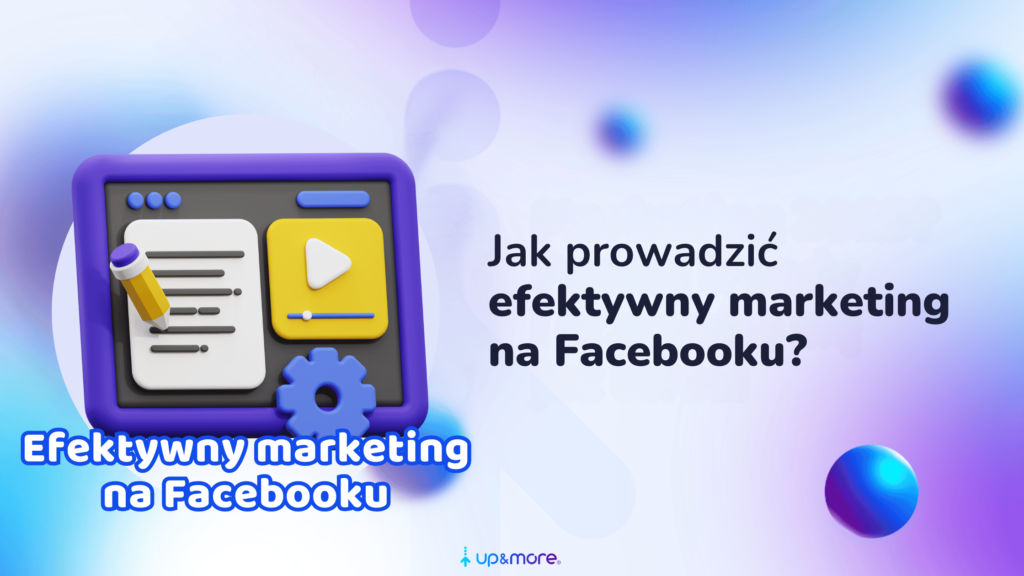
Why is Facebook marketing so important for business growth?
Facebook marketing is very important for business growth because it allows you to reach billions of users and precisely target your ads, opening the door to a huge base of potential customers.
Effective campaigns on this platform significantly expand your brand’s reach and strengthen its online presence. Facebook’s advanced advertising tools allow you to precisely reach your audience, for example, according to their location, age or interests.
Active maintenance of your company profile is essential for building lasting relationships with customers. Regularly publishing engaging content and interactions, such as responding to comments, help the brand show a more human face and strengthen audience loyalty.
Combining organic activity with paid advertising campaigns brings tangible benefits, supporting sales. However, it is essential to constantly monitor the effectiveness of ads. This allows you to optimize future activities, manage the budget more effectively and ultimately increase the return on investment (ROI), which translates into real profits for the company.
Active presence on Facebook has a real impact on consumer purchase decisions, so it is an indispensable element of an effective marketing strategy.
How to define the ideal target audience on Facebook and how to reach it?
Defining the ideal target audience on Facebook begins with analyzing the demographics, interests, behavior and location of potential customers using Facebook’s tools. The platform’s advanced options make the process easier, allowing you to select based on age, gender, language, education, position, income and even major life events.
Facebook’s Ad Manager allows you to pinpoint who your ideal customer is, taking into account their needs and expectations. It’s worth remembering that the goal of a campaign doesn’t always have to be direct sales – it could just as well be brand awareness or lead generation. It is extremely helpful here to analyze data from tools such as Meta Business Suite or Google Analytics, which provide valuable information about your current customers, making it easier to create an accurate customer profile.
The Meta platform also allows you to create Custom Audiences. These can be built based on data from:
- your website (this requires installation of the Meta Pixel),
- a mailing list,
- activity in the mobile app,
- interaction with your Facebook or Instagram profile.
This is a great remarketing tool, allowing you to target ads to people who have already interacted with your brand.
Another powerful tool is Lookalike Audiences. The Meta system searches for Facebook users with characteristics similar to your best customers, people on your mailing list or fans of your page. In this way, you can effectively expand your reach and reach completely new people who are potentially interested in your offer.
Defining your target audience is not a one-time task, but an ongoing process. It is very important to test different targeting criteria, carefully analyze the results of the campaign, metrics such as CTR, CPC, conversions and ongoing optimization of settings. In doing so, be careful not to narrow the audience too much, which could limit the algorithm’s capabilities. Remember that precise ad targeting is the best way to reduce unnecessary spending and maximize marketing ROI.
What types of content engage users most on Facebook?
The most engaging content on Facebook is a variety of valuable content tailored to the audience, including, above all, visual, interactive and user-generated formats.
Visual content is especially important – bet on high-quality photos and videos, not forgetting dynamic formats like live broadcasts and Rollups. It’s important that the materials are original and fit your brand’s communication style.
It is also worthwhile to engage your audience through:
- interactive posts – surveys, questions thrown to the community, quizzes or contests are proven ways to encourage active participation,
- user-generated content (UGC) – opinions, reviews or product photos submitted by customers reinforcing trust and brand authenticity,
- stories – an ideal place to show a more human, everyday face of a company, reveal a behind-the-scenes secret or announce instant promotions,
- content content – sharing how-to guides or interesting blog articles builds a position as an expert and engages an audience looking for specific information.
How to create an effective Facebook advertising campaign step-by-step?
In order for a Facebook campaign to produce the desired results, it is necessary to go through several important steps. Careful execution of each of them significantly increases the chances of achieving your goals, both marketing and business. Key steps include:
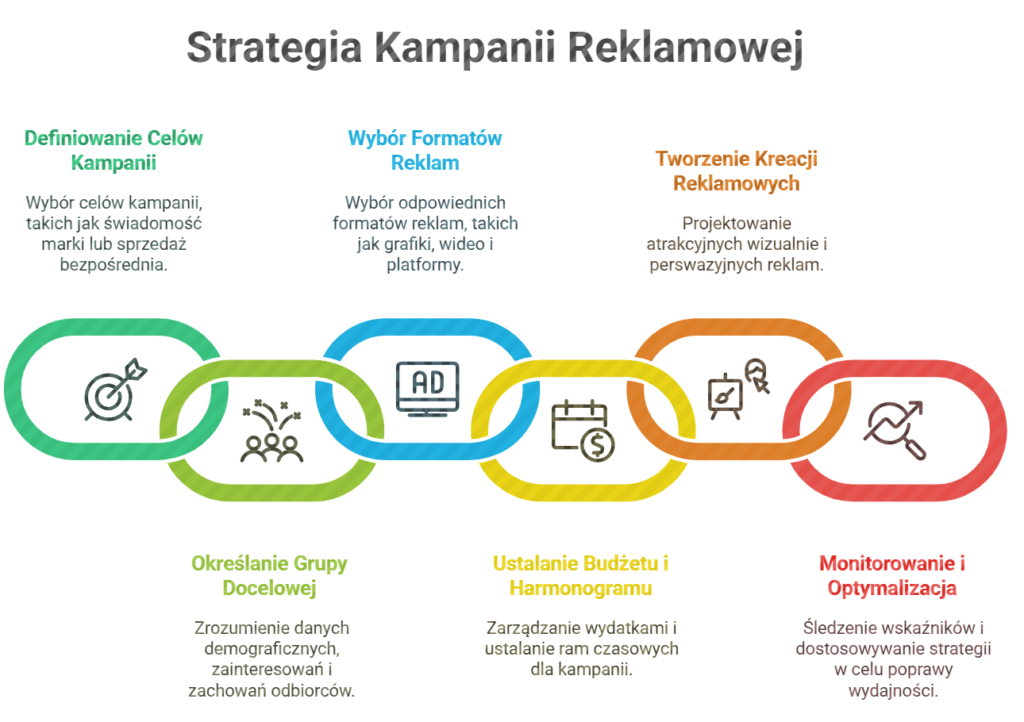
Remember that regular improvement of your efforts is the basis for achieving maximum results.
How to choose the right type of Facebook ad for your goals?
Choosing the right type of Facebook ad depends on the main goal of your campaign. Think about what you want to achieve, and then adjust the ad format that will best support your efforts.
If your priority is to increase brand recognition, choose graphic or video ads – they attract attention and stay in the audience’s mind. In the case of e-commerce, when you want to present a wide assortment, product carousels or collections that allow you to show multiple products at once are ideal.
Want to collect contacts from potential customers, i.e. generate leads? Lead Ads are the most effective solution – they are easy to use and bring great results. If you care about direct sales growth, bet on product or dynamic ads, which direct users straight to your offer and encourage with attractive promotions. In addition, event ads effectively promote the initiatives you organize, and those in Messenger help build closer relationships with your audience.
Remember that the most important thing is to clearly define the goal of the campaign. Choose the right ad format and get started!
How to effectively target Facebook ads to reach the right audience?
To effectively target Facebook ads and reach the right audience, remember to precisely define your target audience. The most important step is to analyze the interests, demographics and behaviors of potential customers, which allows you to create a campaign tailored to their needs and expectations.
Use the tools available on the platform, such as Facebook Ads Manager, to accurately define targeting parameters and monitor ad results. Remember that regular testing of different settings and optimization of your campaign are essential to achieve the best results.
How much does it cost to advertise on Facebook and how to effectively manage your advertising budget?
The cost of advertising on Facebook depends on a number of factors, such as the level of competition, the selected target audience, location, time of day, ad type and the stated goal of the campaign. The average rate per click is about $1.72, but this amount can vary depending on the industry or precision of targeting. The billing system is based on the PPC (Pay Per Click) model, which means you only pay for actual clicks. Importantly, you have full control over your spending – you can set a daily limit as low as $1 or set a budget for your entire campaign.
Effective management of your advertising budget requires a strategic approach. In order to maximize your return on investment (ROI), it’s a good idea to follow a few important rules. Here are practical tips on how to optimize your Facebook campaigns:
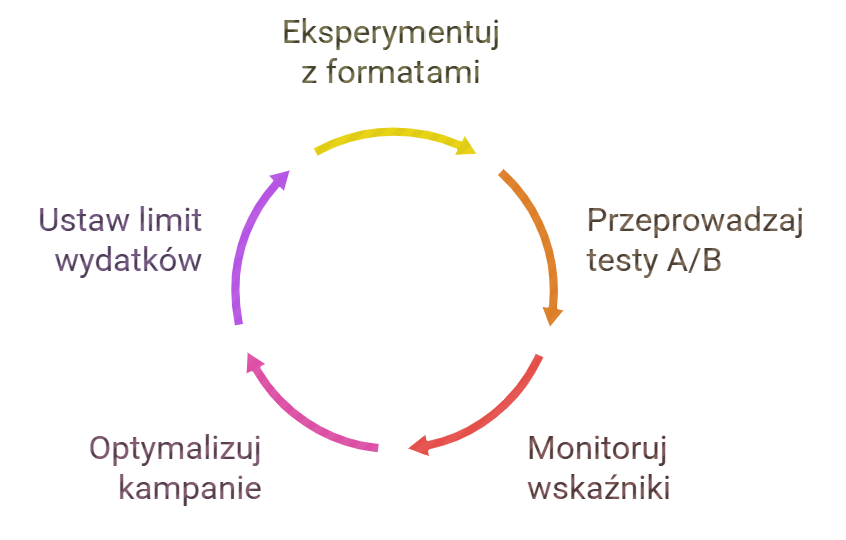
With these steps, you will increase the effectiveness of your advertising efforts while minimizing the risk of overspending.
How to measure the effectiveness of your Facebook marketing efforts and analyze the data?
To effectively evaluate your Facebook marketing efforts, it’s a good idea to use dedicated tools such as Meta Business Suite or Ad Manager. They allow detailed analysis of metrics such as reach, number of impressions, click-through rate (CTR), cost per click (CPC) or return on investment (ROI). Thanks to this data, you will quickly verify whether your campaigns are bringing the expected results, for example, in the form of an increase in sales.
No less important is monitoring the audience’s reaction to the published content. The number of likes, comments and shares is a clear signal of whether your posts are hitting the tastes of your target audience. In turn, analyzing conversions – such as purchases or newsletter signups – allows you to assess how your social media activities support your business goals. For this purpose, the Meta Pixel, which precisely tracks user activity on your website, proves indispensable.
Additionally, it is worth experimenting and optimizing campaigns. A/B testing allows you to compare different versions of your ads to determine which elements – content, graphics or call to action (CTA) – work best. Regular analysis of audience data in Meta Ads Manager, on the other hand, helps to better adjust targeting, making campaigns more effective and yielding better results.
The effectiveness of Facebook marketing efforts is measured primarily through tools such as Meta Business Suite and Ads Manager, analyzing the most important metrics: reach, CTR, CPC and ROI.
What performance indicators (KPIs) to track in Facebook campaigns?
The most important KPIs to monitor are click-through rate (CTR), average cost per click (CPC) and return on investment (ROAS). These metrics provide information about how your ad is resonating with your audience and what financial results it is delivering.
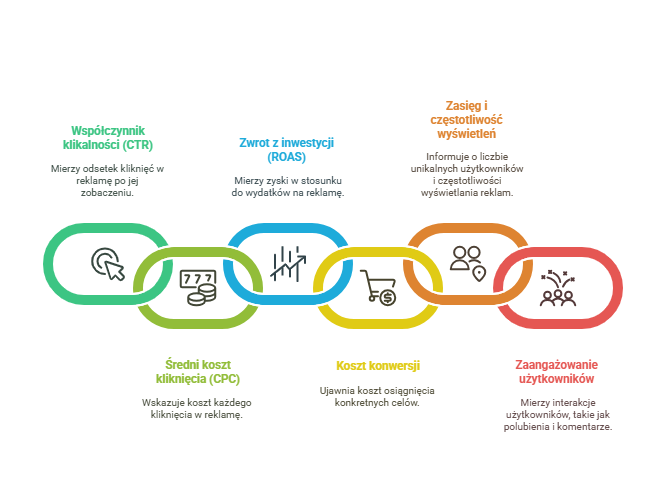
Regular monitoring of these metrics in Meta Ads Manager is the foundation of an effective strategy. Analyzing the data allows you to adjust your campaigns on an ongoing basis – whether by changing your target audience or modifying your ad content. This will help you reach your audience more precisely and increase the chances of better sales results.
How to use Meta Pixel to track conversions and optimize ads?
Meta Pixel is a powerful tool that allows you to effectively track conversions and optimize your Facebook ad campaigns. With it, you can easily find out what actions users take on your page after seeing an ad – whether they make a purchase, sign up for a newsletter, or perhaps browse specific products. Such knowledge allows you to accurately assess the effectiveness of your marketing efforts and adjust your strategy to meet real needs.
Installing Meta Pixel on your website is extremely simple and fast. Once the code is in place, you can collect valuable visitor data and then create personalized audiences, such as people who have visited your site in the last 7 days. This is an excellent basis for remarketing, which significantly increases the chances of completing a transaction.
Pixel also supports ad optimization. The Meta system automatically targets your campaigns to users who are most likely to perform a desired action, such as a purchase. As a result, you achieve more conversions at a lower cost-per-click, which translates into real savings and a better return on investment.
In the Ad Manager you will find detailed reports that will provide you with information about the number of impressions, clicks or cost per customer acquisition. Analysis of this data will allow you to adjust your strategy even better and manage your advertising budget more effectively. For any business that wants to maximize the potential of Facebook ads, Meta Pixel is an absolutely essential tool!
How to keep up with changes and trends in Facebook marketing?
To keep up with the dynamic changes and trends in Facebook marketing, it’s a good idea to act strategically and stay on top of the news. The most effective way to do this is to regularly follow algorithm updates and new platform features, such as Reels, which can significantly increase the reach of your content. Experiment with different video formats – short, dynamic clips often attract users’ attention. Also take advantage of Instagram integration and innovative augmented reality (AR)-based ads to differentiate your brand from the competition.
To effectively develop your expertise and adapt your strategies to changing realities, use the following tips:

With a consistent approach, you will not only stay on topic, but you will also strengthen your brand image and increase sales.
How to use Facebook to build a strong community around your brand?
To build a strong community around your brand on Facebook, it’s a good idea to focus on regularly publishing a variety of content that will grab your audience’s attention and encourage them to interact. Don’t limit yourself to one format – share photos, record videos, create polls or short stories in Stories. Such variety makes users more likely to engage with your posts. Equally important, respond quickly to comments and private messages – this builds trust and strengthens customer relationships.
A great way to increase engagement is through contests and events on the platform. Simple activities, like prize giveaways, can significantly increase the reach of your posts. You should also consider setting up themed groups related to your brand. This is a place where fans can exchange opinions and build closer relationships, which further strengthens their bond with your brand.
Don’t forget about the potential of tools such as Facebook Live. Live broadcasts attract attention and generate as much as six times more responses than standard posts, Meta analysis confirms. However, the most important thing is to maintain regularity and a consistent style of communication. Take care of the aesthetics of the materials you publish and keep an open dialogue with your audience, for example, answering their questions. This approach not only improves your brand image, but also helps create a genuine, engaged community.
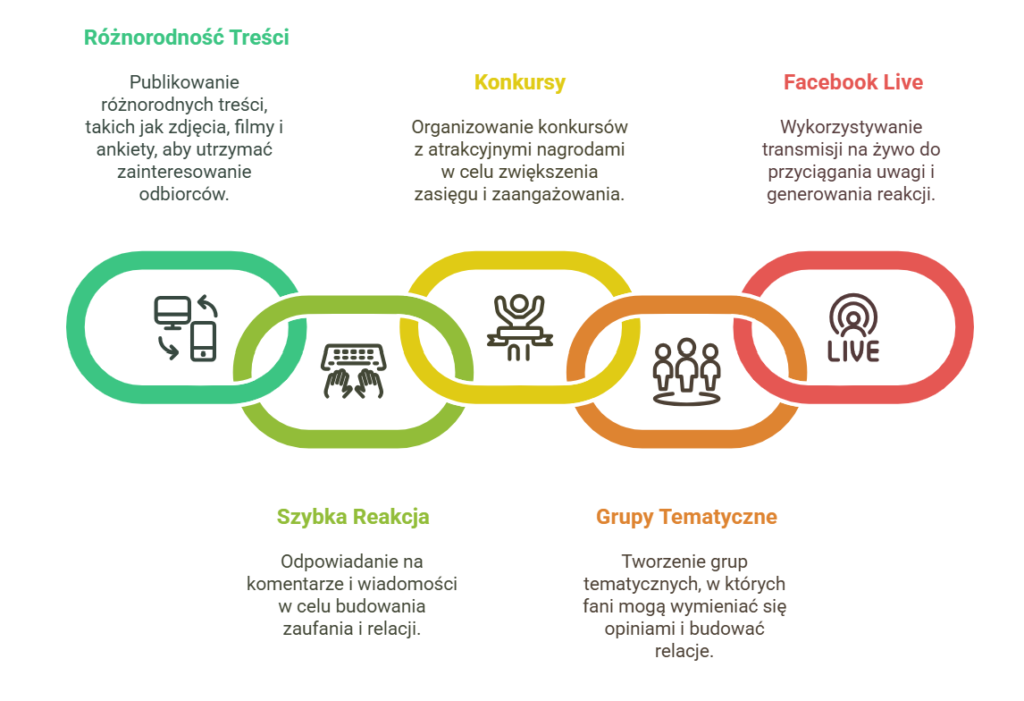
How to integrate Facebook marketing with a company’s other marketing efforts?
Integrating Facebook marketing with a company’s other efforts is the key to creating a cohesive and effective strategy that combines the various platforms into a harmonious whole. The idea is to ensure a consistent brand message – both visual and tonal – on Facebook, Instagram, newsletters or the website, which builds trust and increases recognition.
Facebook also provides valuable data to personalize marketing efforts. Using information from the Meta Business Suite, you can precisely target ads, reaching the right audience. The same data will allow you to customize the content of your mailings, which, as HubSpot research shows, increases the effectiveness of your campaigns by up to 14%.
The cross-promotion of content between channels is also extremely important. Sharing a link to a blog article through a fanpage can significantly increase traffic. In turn, publishing excerpts from webinars or Instagram posts on Facebook allows you to reach a wider audience and maximize your reach.
The platform is also a powerful tool for generating leads. With Lead Ads, you can collect contact information directly in the app and then use it in sales or remarketing campaigns, such as Google Ads. This synergy between tools strengthens the buying process and significantly improves results.
An important part of the integration is monitoring the effects of activities. Using Meta Pixel or Google Analytics, track metrics such as ROI or CTR. This allows you to optimize spending on an ongoing basis and adjust your strategy to meet changing needs. Consistency, however, remains the foundation – a well-thought-out strategy, combining Facebook with other channels, not only builds a solid brand image, but also engages customers on a whole new level.
What are the most common Facebook marketing mistakes and how to avoid them?
The most common problem with Facebook marketing is the lack of a well-thought-out strategy, resulting in chaotic actions and wasted resources. Many companies make mistakes, such as misguided ad targeting, publishing unengaging content or ignoring analytics data, which is the most important for evaluating the effectiveness of a campaign. What’s more, over-promotion can drive audiences away, with many users turning away from brands that are too pushy, leading to a loss of trust.
Learn practical ways to make your efforts yield better results.
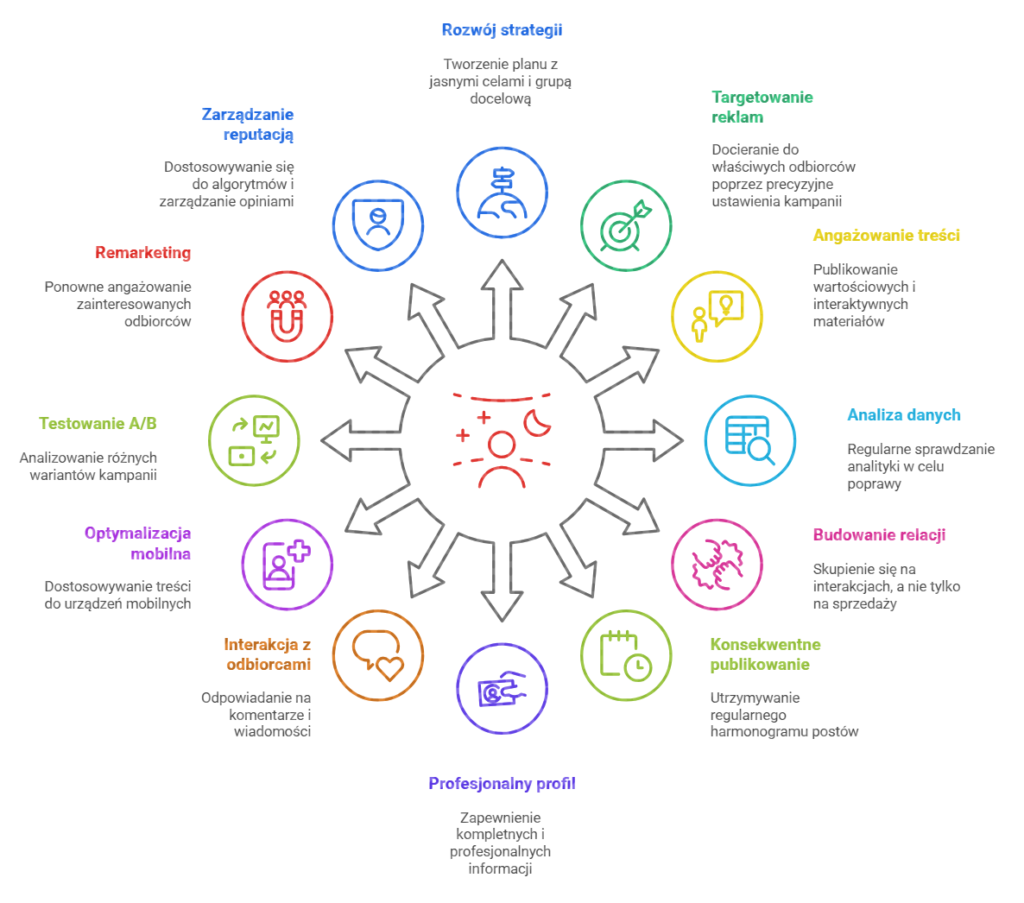
How to be effective on Facebook? Develop a solid marketing plan and precisely define your target audience. Publish valuable content regularly, experiment with ad forms and analyze results in Meta Business Suite to continuously improve your campaigns. Build relationships with your audience by responding to their comments and messages. Use benefit language in your ads and optimize content for smartphones. Review your profile regularly to catch shortcomings and improve results. Effective Facebook marketing doesn’t have to be complicated – all you need is consistency and openness to data.
Summary
Effective Facebook marketing is more than just a social media presence. It’s a way to realistically reach people who may be interested in your offer – provided you have a good understanding of who they are and what reaches them.
In the article, we showed you how to plan step-by-step, from defining your target audience, to choosing an ad format, to analyzing results and adjusting your budget. We also looked at what content engages the most, how the Meta Pixel works, and why it’s worth tracking specific data instead of acting „by eye”.
Facebook offers a lot of possibilities, but what really counts is consistency, observation and willingness to test different solutions. A good plan, regular analysis and knowledge of your community are the elements that make a real difference between whether a campaign will have an effect or be quickly forgotten.
Finally – Facebook marketing does not work in isolation. The better it is combined with your company’s other activities, the greater the chance that it will translate into something more than just numbers in the statistics.
The better it is combined with your company’s other activities, the greater the chance that it will translate into something more than just numbers in the stats.
Was the article helpful?
Rate our article, it means a lot to us!
Let's talk!
Specjalistka od mediów społecznościowych z kilkuletnim doświadczeniem. Na co dzień zajmuje się tworzeniem angażujących treści, budowaniem strategii komunikacji i analizą wyników działań w social mediach. Zafascynowana możliwościami marketingu cyfrowego, chętnie eksploruje nowe trendy i narzędzia, by skutecznie wspierać rozwój marek.